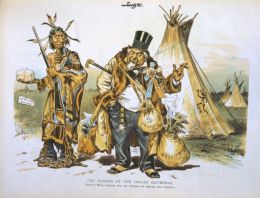Indian removal was a simple
idea in the minds of southerners, but the practicalities of
relocating that many tribes to homelands thousands of miles away
was daunting and fraught with unintended consequences.
In many cases,
the land set aside for specific tribes was already occupied and
settled by whites. The local Indians had to agree to accept
reduced territories, and, in some cases, relocation, once
again. This was work that fell to Indian Superintendent
William Clark, in St. Louis, who was pushed by events beyond his
control to negotiate new treaties with the Kansas, Osages, Quapaws,
and others at the same time he was opening land west of Missouri
and Arkansas for eastern tribes.

The First Removal Era
in the east flowed without interruption into the Second Removal
Era, which displaced western tribes from treaty protected
homelands. The Third Removal Era began in the 1950s, when
Congress attempted to force Indians off their home reservations
with threats of terminating tribal governments, with forced
relocation programs, and by condemning their homelands under
eminent domain in order to build massive flood control dams on the
Missouri River. it is important to note that each of these
removal eras was eventually ruled unlawful by the U.S. Supreme
Court, or by Congress itself. These repeated and devastating
forced relocations have left deep scars of resentment and distrust
in the relations between tribal governments and non-Indian
people.
http://en.wikipedia.org/wiki/Indian_removal

But many of the eastern tribes were
still very reluctant to move. Congress and
President Jackson ignored imperatives of nature (not to mention
their legal obligations), and the Indians opposition. Tribal
leaders urged Jackson to obey the dictates of the high court, which
ruled against removal, but knowing that Justice Marshall had no way
to enforce his decisions, Jackson pressed ahead with removal over
the court's objections. At this point, Jackson's
failure, ne, his refusal to fulfill his constitutional obligations
to the tribes destroyed what resolve they had left. Now, many
Indians abandoned their resolve to stand and fight and began moving
West.
Factions of Cherokee, Creek,
and Seminole's refused to emigrate. Despite Jackson's empty
words to Congress that emigration "should be voluntary for it would
be as cruel as it was unjust to compel the aborigines to abandon
the graves of their fathers," he sent federal and state troops to
round up the recalcitrant Indians and set them off on forced
marches under military guards.
The resulting 'trails of
tears' rank with the great tragedies of the ages. Although
federal officials were responsible for supervising the removal,
private contractors were hired to supply rations and
transportation, with disastrous results. The Cherokee, for
example, were caught on the overland trail in midwinter, enduring
freezing temperatures, snow, ice storms, and sudden thaws that
bogged down the pack trains in knee-deep mud. If these
conditions weren't enough misery, add to them rations of spoiled
meat, corn, and flour supplied by the disreputable
contractors. The tribes on the trail lost one fourth of
their people.
The survivors
claimed that the suffering and deaths were due to the callousness
of the contractors, whom, they said, had used the plight of the
Indians to line their own coffers. The anger over
charges of profiteering and fraud was so fierce that officials in
Washington hired Major Ethan Allen Hitchcock to investigate the
complaints. An investigator for the Smithsonian Institution's
Bureau of American Technology, John R. Swanton, applauded the
appointment: "Since…the national administration was willing to look
the other way while this criminal operation was in progress, it
made a curious blunder in permitting the injection into such a
situation of an investigator as little disposed to whitewash as was
Ethan Allen Hitchcock."
Hitchcocks's
investigation commenced in November, 1841. Soon, the cautious
but fearless Hitchcock found that "bribery, perjury, and forgery,
short weights, issues of spoiled meat and grain, and every
conceivable subterfuge, was employed by designing white men on
ignorant Indians."
Hitchcock's
report, along with one hundred exhibits, was filed with the
secretary of war. Committees of Congress demanded the right
to review the material, but the findings in the report were so
scandalous, said Swanton, that the secretary of war refused to make
it public, and "…its mysterious disappearance from all
official files proves at one and the same time the honesty of the
report and the dishonesty of the national administration of the
period."
Related People
Related Events
Related Flashpoints
Related Places